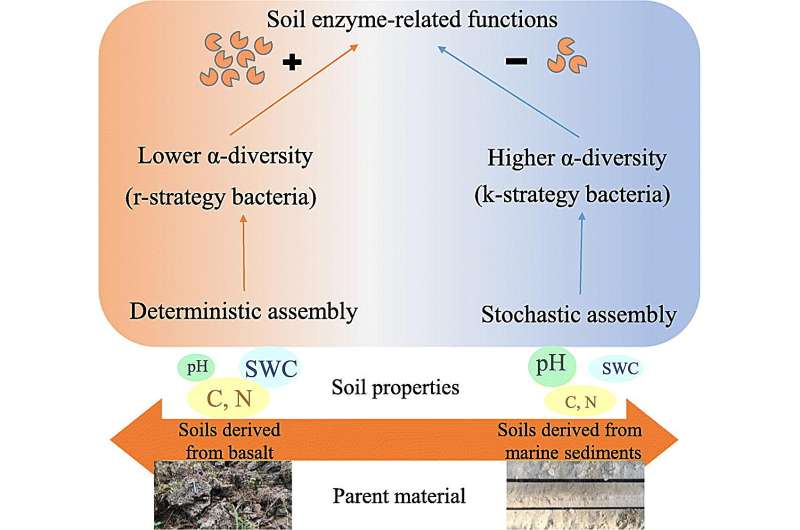This article has been reviewed according to Science X's editorial process and policies. Editors have highlighted the following attributes while ensuring the content's credibility:
fact-checked
peer-reviewed publication
trusted source
proofread
Studies on Hainan Island rubber plantations reveal secrets of soil

Microscopic life thrives beneath our feet, playing a crucial role in soil health and carbon storage. Researchers from the Institute of Applied Ecology of the Chinese Academy of Sciences have been delving into the mysteries of how different soil types affect these microbial communities and their impact on underground processes.
Their series of studies, conducted across Hainan Island, focused on rubber plantations—a key economic tree species in the region. The results, published in three separate journals, shed light on the complex interplay between parent material, microbes, and soil processes.
In their first study published in Geoderma Regional, the researchers showed how the underlying rock layer, known as parent material, affects the balance of key nutrients such as carbon, nitrogen, and phosphorus in the soil. They found that basaltic soils, formed from volcanic rock, had a higher phosphorus content but lower nitrogen levels than marine sedimentary soils.
This imbalance suggests that tailoring nutrient management for rubber plantations based on soil type could be beneficial. For example, adding phosphorus to basaltic soils and nitrogen to marine sedimentary soils could optimize plant growth.
Taking a closer look at the microbial world within the soil, in the second study published in Science of The Total Environment, the researchers examined how these parent materials shape bacterial communities. They found that these communities adapt to their environment. In basaltic soils with lower pH and higher moisture, the bacterial populations were less diverse but showed higher activity in degrading carbon and nitrogen.
Conversely, marine sedimentary soils, with lower moisture and nutrients, supported more diverse bacterial communities with enhanced abilities to utilize harder-to-decompose materials.
In the third study published in Soil Biology and Biochemistry, they investigated the two-way impacts of parent material and vegetation on microbial communities, and the contribution of microbial remains to soil carbon. They found that rubber plantations, compared to other vegetation types, had a higher accumulation of dead microbial material. This suggests a rapid microbial life cycle in the tropical climate studied.
Importantly, the type of clay minerals present in the soil also influenced the microbial necromass (dead remains). Clay soils derived from basaltic rocks provided better protection for these remains, promoting their accumulation and contribution to soil carbon storage. In contrast, sandier soils favored fungal communities, whose remains contributed differently to the total carbon content.
Together, these three studies collectively provide valuable insights for nutrient management in rubber plantations and for understanding how to enhance soil carbon sequestration in tropical regions. By unlocking the secrets of the soil microbial world, scientists are paving the way for more sustainable rubber plantation management practices.
More information: Yuzhu Li et al, Soil total and available C:N:P stoichiometry among different parent material soil profiles in rubber plantations of Hainan Island, China, Geoderma Regional (2024). DOI: 10.1016/j.geodrs.2024.e00765
Yu-Zhu Li et al, Toward soil carbon storage: The influence of parent material and vegetation on profile-scale microbial community structure and necromass accumulation, Soil Biology and Biochemistry (2024). DOI: 10.1016/j.soilbio.2024.109399
Yu-Zhu Li et al, Parent material influences soil properties to shape bacterial community assembly processes, diversity, and enzyme-related functions, Science of The Total Environment (2024). DOI: 10.1016/j.scitotenv.2024.172064
Journal information: Science of the Total Environment , Biochemistry
Provided by Chinese Academy of Sciences




















